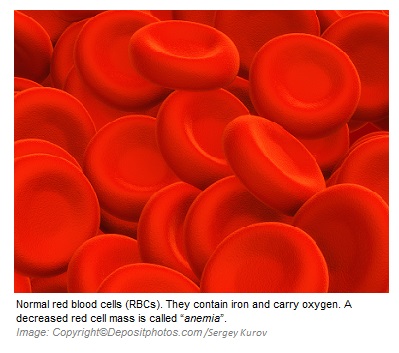 level or both. Signs and symptoms of anemia depend on its severity and chronicity. They include fatigue, tiredness, weakness, brittle nails, atrophic tongue, exertional dyspnea, dizziness, cold extremities, looking pale, palpitation, chest pain, inflammation of tongue, pica, jaundice, and tingling and numbness in hands and feet.
level or both. Signs and symptoms of anemia depend on its severity and chronicity. They include fatigue, tiredness, weakness, brittle nails, atrophic tongue, exertional dyspnea, dizziness, cold extremities, looking pale, palpitation, chest pain, inflammation of tongue, pica, jaundice, and tingling and numbness in hands and feet.
Anemia is either due to excessive blood loss (bleeding), destruction of red blood cells (hemolysis), or insufficient production of red blood cells. Anemia has a wide variety of causes. However, the main causes of anemia are iron, vitamin B12, and folic acid deficiencies. In iron deficiency anemia, the red blood cells are usually smaller in size (microcytic), while red blood cells are bigger in size in B12 and folic acid deficiencies (macrocytic).
Potential contributing factors for developing anemia:
- Iron deficiency:
- Occult bleeding from gastrointestinal tract (e.g. peptic ulcer, and cancers).
- Heavy monthly menstruation.
- Vegetarians.
- Minor thalassemia.
- Lead toxicity.
- Vitamin B6 deficiency.
- Zinc deficiency.
- Vitamin B12 deficiency:
- Pernicious anemia.
- Removing the whole or a part of the stomach.
- Poor function of the pancreas.
- Bacterial overgrowth (imbalance between good and bad bacteria).
- Diseases of the terminal section of the small intestine.
- Parasite infestation.
- Vegetarians.
- Low function thyroid.
- Celiac disease.
- Folic acid deficiency:
- Alcoholism.
- Pregnancy.
- Breastfeeding.
- Hemolysis (destruction of red blood cells).
- Cancers.
- Crohn`s disease.
- Celiac disease.
- Anti-folate medications: methotrexate, and sulfa medications.
Nutritional Supports:
Restricted Foods:
- Dairy products, especially cow milk.
- Black tea.
- Coffee.
- Alcohol.
- Carbonated beverages.
- Fats.
- Sugars and sweets.
- Red wine.
- Foods high in oxalate: beets, chard, chocolate, cocoa, collard greens, currants, eggplants, corn grits, kale, okra, leeks, parsley, rhubarb, rutabagas, spinach strawberries, summer squash, and wheat germ. Oxalate inhibits the absorption of iron.
Recommended Foods:
- Liver.
- Red meats.
- Green leafy vegetables except parsley and spinach.
- Brewer`s yeast.
- Foods high in vitamin C: citrus fruits, tomatoes, potatoes, oranges, grapefruits, melons, berries, broccoli, Brussels spout, cabbage, salad greens, green peppers, and cauliflower. Vitamin C increases absorption of iron.
- Foods high in copper: oyster, nuts, eggs, legumes, and dark green leafy vegetables.
Recommended Supplements:
Iron Deficiency:
- Iron: 50 – 100 mg a day.
- Vitamin C: 1000– 2000 mg a day.
- Vitamin B – Complex: A high potency product.
B12 and Folic Acid Deficiencies:
- Vitamin B 12: 1000 – 2000 mcg a day.
- Folic acid: 1000 mcg a day.
- Vitamin B – Complex: A high potency product.
Anemia in Thalassemia:
- Folic Acid: 1000 mcg a day.
- Magnesium: 200 – 400 mg a day.
- L – Carnitine: 1000 – 2000 mg a day.
- Vitamin E: 400 IU a day.
Miscellaneous Suggestions:
- Spirulina: as a tablet: 2000 – 3000 mg a day, or as a powder: 2 – 3 teaspoons a day. Spirulina may stimulate bone marrow to produce red blood cells.
- Zinc: 50 – 100 mg a day. Zinc deficiency may show itself as an iron deficiency anemia resisting to treatment.
- Vitamin B6: 100 – 200 mg a day.
- Copper: 2 – 4 mg a day. Copper has a key role in red blood cell formation.
- Multivitamins – Multiminerals: A high potency product.

